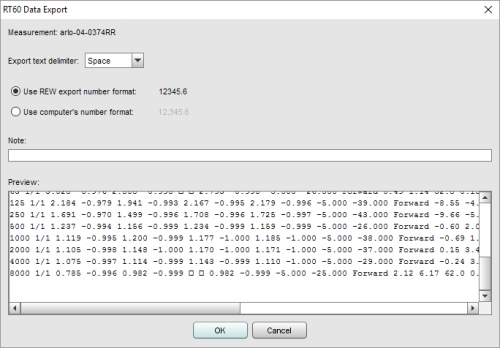The SPL calibration offset for the current input is used for the imported data, unless the import has float values with magnitudes larger than 10 (the usual maximum for WAV files is 1). In that case REW assumes the values are attempting to encode SPL figures directly and generates an SPL calibration offset for the measurement accordingly, ensuring that the magnitude of the peak of the resulting IR is 1.0.
To adjust the SPL offset for a desired peak SPL figure in the frequency response use the Scale Response controls in the Impulse graph group. There is a setting in the Analysis Preferences to control whether the t=0 time for the imported response is placed at the first data sample, at the peak of the impulse response or at the specific sample index shown. The path to the file is remembered for the next time the dialogue appears. WAV, AIFF and .pcm files can also be opened by dragging them onto the main REW window. N.B. Mic/Meter calibration, soundcard calibration and C weighting compensation are not applied to imported impulse responses. Use the Change cal button on the measurement panel to apply calibration data after import.
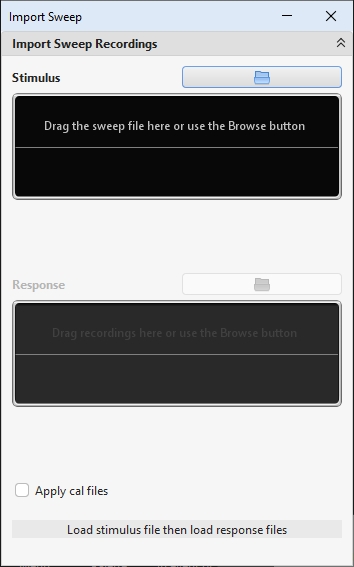
The dialog provides options to choose whether to export the measured IR, the IR after any EQ filters have been applied to it or a minimum phase version of the IR.
The response can optionally be normalised so that the peak value is unity (0 dBFS). There is also an option to apply the current impulse response window settings to the response before exporting it and an option to place t=0 at a specific sample index in the export. The export can be limited to a specific sample count if desired.
The peak of the exported response occurs 1 second after the start unless the IR window has been applied or the option to place t=0 at a specified sample index is chosen. If the IR window has been applied the export starts at the first windowed sample and the peak location depends on the IR window settings, unless the option to place t=0 at a specified sample index is chosen. Either can be used to preserve relative timing for exported impulse responses that have been captured with a timing reference. If t=0 is placed at a specific index that preserves the timing, otherwise define IR windows for the responses that have the same window ref time and the same left window width - use rectangular windows if the data should not be altered by the window. The exported IR for each impulse will then start at the start of the left window, which will be at the same absolute time for each, so their relative timing will be preserved. If the minimum phase version is exported with the option to apply windows selected t=0 will be the width of the left window after the start of the export.
The response can be exported at multiple sample rates, the data is resampled using a windowed sinc for sample rates other than the native rate of the measurement.
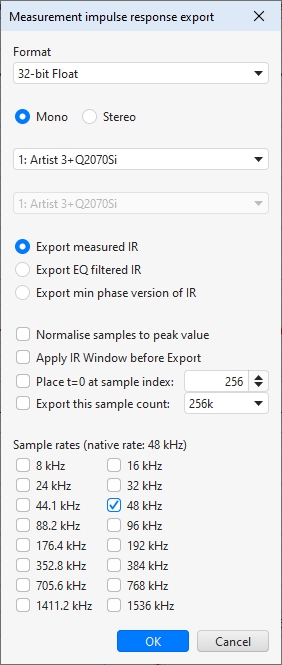
Filter Settings file
Room EQ V4.00
Dated: 07-Jan-2007 17:20:32
Notes:Example filter settings
Equaliser: DSP1124P
sampledata.txt
Bass limited 80Hz 12dB/Octave
Target level: 75.0dB
Filter 1: ON PA Fc 129.1Hz ( 125 +2 ) Gain -18.5dB BW/60 4.0
Filter 2: ON PA Fc 36.8Hz ( 40 -7 ) Gain -15.5dB BW/60 10.0
Filter 3: ON PA Fc 99.1Hz ( 100 -1 ) Gain -3.5dB BW/60 1.0
Filter 4: ON None
Filter 5: ON None
Filter 6: ON None
Filter 7: ON None
Filter 8: ON None
Filter 9: ON None
Filter 10: ON None
Filter 11: ON None
Filter 12: ON None
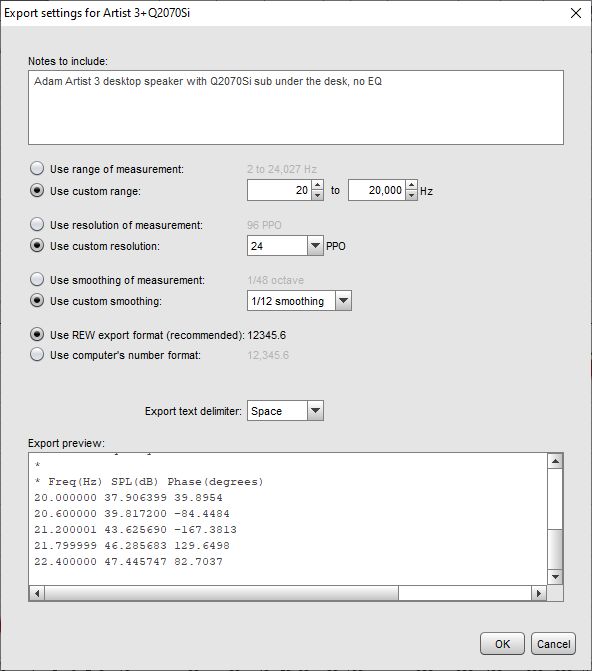
The entire measurement can be exported (Use range of measurement) or a range can be selected, if the selected range starts before or ends after the range of data within the measurement only the range that overlaps the measurement will be exported. If the data is exported at the measurement resolution that may be 96 PPO log spaced if the Allow 96 PPO log spacing Analysis preference is selected or linear spaced at the FFT resolution. Linear spaced exports are very large files (typically more than 1 MB). If a custom (log spaced) export resolution is selected REW picks a start frequency that is as close as possible to the desired start but that ensures the exported frequencies include the nominal octave centres (e.g. 20 Hz, 40 Hz etc). Smoothing should be applied when using log exports, the dialog will warn if insufficient smoothing has been selected for the chosen output resolution. Exports can use whatever smoothing is currently applied to the measurement, or any other smoothing selected from the dialog (the selection will not change the smoothing of the measurement in REW, only the smoothing for the exported data). By default REW's export number format uses dot as the decimal delimiter and no digit grouping, for ease of import in other packages subsequently, but Use computer's number format will mean the current format of the computer on which REW is running will be used. The delimiter between exported values can also be selected here, this is the same selection as offered in the export menu. A preview of the export output is shown in the dialog including the first few lines of exported data. The format is compatible with the .FRD format. Comment lines start with *, data lines begin with the frequency, then the SPL in dB and finally the phase in degrees (0.0 if the measurement does not have phase information).
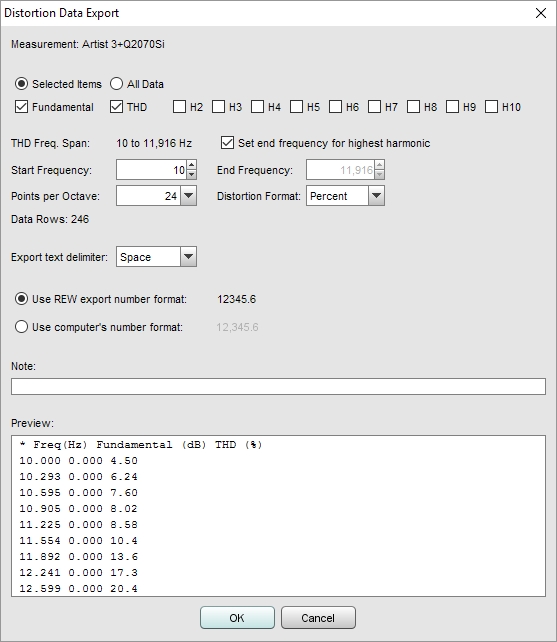
An example of the file format is shown below. Comment lines start with *. Data lines begin with the frequency or, for stepped sine measurements stepped in level, the generator level, then the fundamental SPL (if selected for export) in dB, then the selected distortion measurements. The fundamental will be 0 dB if the distortion data is normalised to the fundamental. Note that if the end frequency for the export is not configured to automatically adjust to suit the highest harmonic selected, the number of harmonics on each line will reduce as frequency increases, eventually leaving only the second harmonic and THD values.
* Distortion data saved by REW V5.01
* Dated: 16-Sep-2012 18:52:27
* Measurement: Sep 16 18:52:27
* Frequency Step: 3 ppo
* Freq(Hz) Fundamental (dB) THD (%) H2 (%) H3 (%) H4 (%) H5 (%) H6 (%) H7 (%) H8 (%) H9 (%) H10 (%)
20.000 76.068 0.016 0.014 0.002 0.001 0.004 0.003 0.001 0.002 0.002 0.001
25.198 76.133 0.011 0.008 0.000 0.001 0.001 0.006 0.001 0.001 0.001 0.003
31.748 76.181 0.015 0.013 0.002 0.002 0.002 0.001 0.002 0.005 0.001 0.001
40.000 76.215 0.014 0.013 0.001 0.003 0.001 0.002 0.002 0.001 0.003 0.001
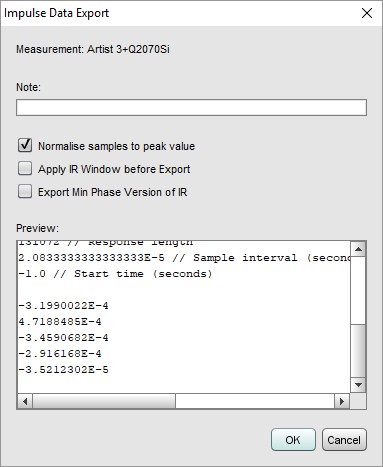
An example of the format is shown below.
Impulse Response data saved by REW V5.19
IR is normalised
IR window has not been applied
IR is not the min phase version
Source: Microphone (Umik-1 Gain: 0dB ), MICROPHONE (Master Volume), Right channel, volume: 0.550
Dated: 05-May-2014 14:12:40
Measurement: Artist 3+Q2070Si
Excitation: 256k Log Swept Sine, 1 sweep at -12.0 dB FS
Response measured over: 2.2 to 24,000.0 Hz
4.33353241533041E-4 // Peak value before normalisation
48000 // Peak index
131072 // Response length
2.0833333333333333E-5 // Sample interval (seconds)
-1.0 // Start time (seconds)
-3.1990022E-4
4.7188485E-4
-3.4590682E-4
-2.916168E-4
-3.5212302E-5
